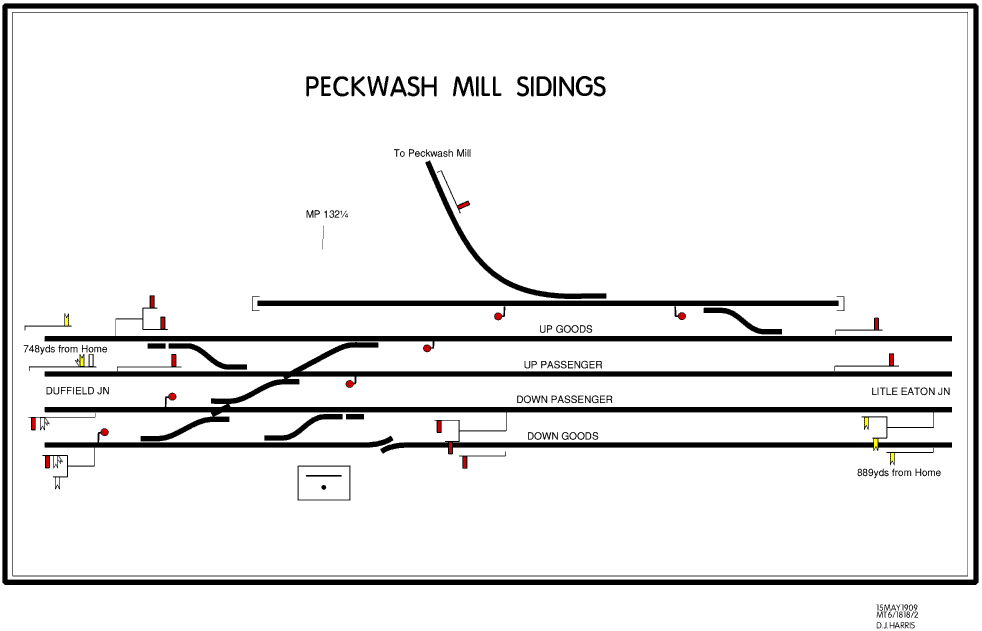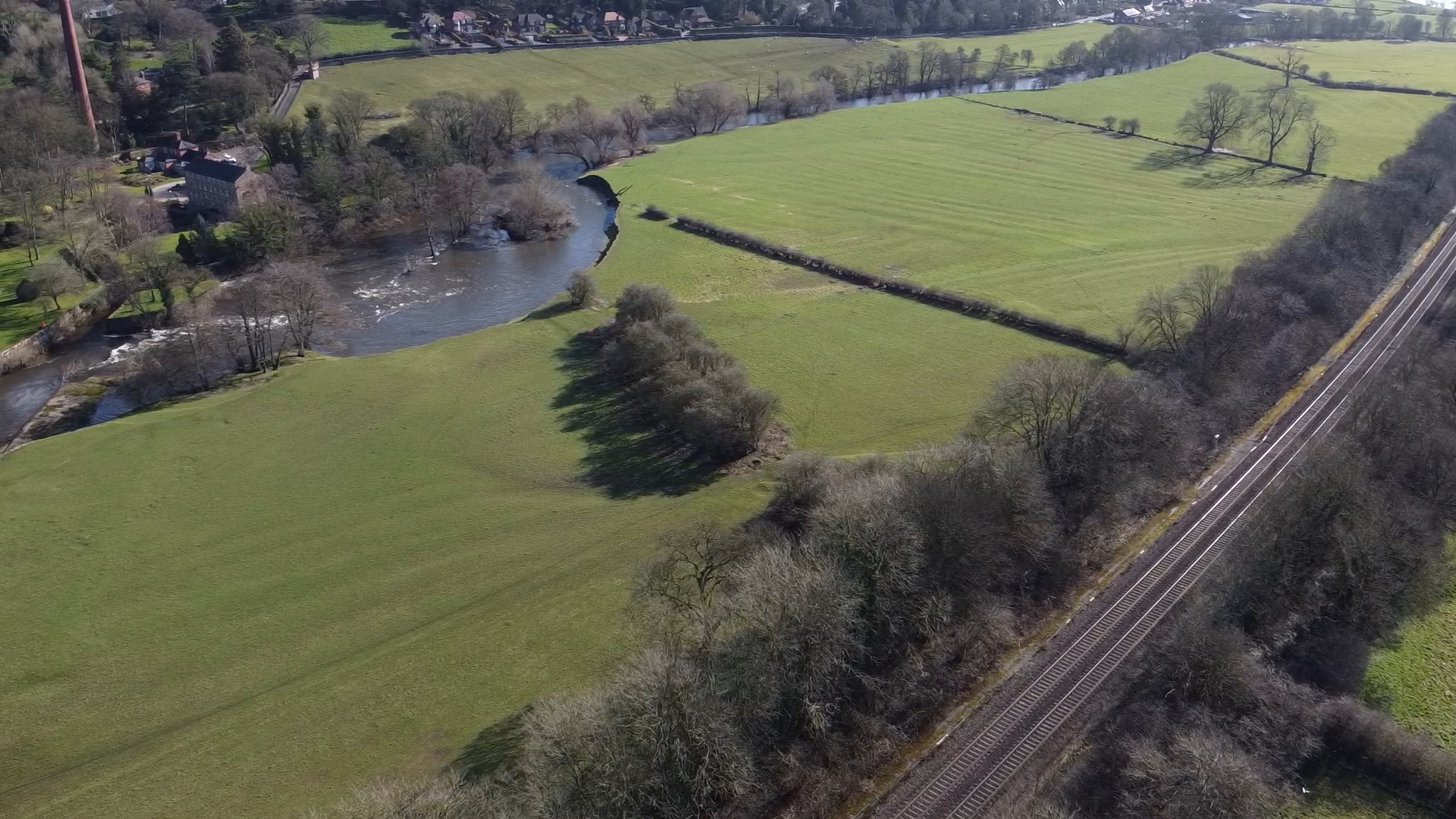Focus on

DERBY AREA SIGNALLING
Focus on

Like most railway installations, Peckwash Mill Sidings evolved slowly over time. Midland Railway records tell us that there was a signal box here by 1877, a time when the practice of centralising control of points and signals in a cabin was only just becoming the norm.
The Peckwash Mill, which of course led to the provision of Peckwash Mill Sidings, owes its existence to the proximity of the River Derwent, the power of which spawned the Industrial Revolution. Mills of one variety or another sprang up all along the Derwent Valley. This particular mill was built by Thomas Tempest in 1805 as a paper mill.
The mill is on the opposite side of the Derwent to the railway and was initially served by a short tramway running at right angles to the main line. A wagon turntable formed the connection with a single siding on the Up side which opened for traffic on 15th December 1877.
Expansion characterised the railways of the Eighteenth Century and the Midland Railway's North Midland line had reached capacity by the end of the century. The solution was to quadruple the route where the topography allowed it. Consequently a third line was added to form an Up Goods line between Duffield Station and Peckwash Mill. The proximity to the river required the railway to be built upon an embankment to keep it above the winter flood level, meaning the provision of extra lines was no easy task.
It was Milford Tunnel to the north of Duffield which dictated the commencement of the Goods Line, that it should end at Peckwash Mill was always intended to be a temporary state of affairs, brought about by the convenience of already having a signal box there to control the junction.
That said, the existing structure, as was the Midland Railway’s practice, would have been a tiny 10’ square “Type 1” cabin, barely large enough to accommodate its existing frame which, in turn, would have been sized according to what it controlled. Thus a new signal box was opened on 14th March 1897 preparatory to the Up Goods Line being taken into use on 4th October 1897.
The provision of the Goods line also marked a change in opening hours, from being “Closed each night and Sundays”, the box became one which was “Open Continuously” .
By now the wagon turntable had been replaced by a direct connection from the Up Siding to the Peckwash Mill line. As the formation crossed the Derwent flood plain, a substantial earthwork was required to carry the line on an extremely tight curve. Even so, the line didn't warrant the term “branch”, remaining a humble tramway. The Ordnance Survey map of the period also shows a lie-by siding on the Down side.
The existing Up siding was not altered by the building of the Up Goods Line. In due course the Goods Line would be extended southwards to Little Eaton Junction and a new Up Siding provided alongside it. In the interim, however, the two lines butted up to one another with their respective stop-blocks back-to-back some 50 yards apart. History records that the embankment between the two stop-blocks was not built up, thus leaving a drop down to the drainage ditch at the foot of the bank.
Like its predecessor, the 1897 Peckwash Mill box was located on the Down side and was to survive to the end. Sited across the line from the 132¼ mile post, it was 1 mile 291 yards from its southern neighbour at Little Eaton Junction and 1,236 yards from Duffield Junction to the north.
The new signal box was an altogether more spacious affair, being formed of two 10’ by 12’ 6” flakes. A flake is a prefabricated section which were fixed together on site and typified the Midland Railway in so many ways. It resulted in a distinctive structure that characterised the Midland's lines and was an extremely efficient way of building. Despite later problems arising as a result of the main timber uprights being anchored in the ground allowing them to rot, these structures longevity belies their builder's actual intentions. Because of the relative simplicity in providing larger structures if required, the Midland rarely built-in room for expansion, presuming the boxes would have to be replaced sooner, rather than later.
Midland Railway signalboxes were remarkably standardised and Peckwash Mill was a quite rare example of a box being 12’ 6” deep (i.e. front to back), the norm being 10’. Whereas the original box probably had a frame of no more than ten levers, the later box had 32, of which only three were spare at the height of its operation.
Following the accident of 1900, the quadrupling was completed. First to open was the Down Goods to Duffield Junction on 8th September 1901 with the section from Breadsall Crossing, beyond Little Eaton Junction, opening on 6th October. On the Up Goods, the section to Little Eaton Junction was taken into use on 5th January 1902, following the course of the former lie-by siding.

It would appear that when the Up Goods was completed the Midland saw fit to remove the connection from it to the Up Passenger line. It must have been a short-sighted plan as it was replaced on 23rd May 1909. The 1909 layout was curious in that whilst there was a “ladder” trailing across all four lines, the facing connection from Down Passenger to Down Slow was a separate feature.
The Midland Railway were justly praised for the method of Block Telegraph working they implemented in later years on their passenger lines. Known as Rotary Interlocking Block, it required the arrival of a train to be proved by it passing over a treadle in advance of (i.e. past) the protecting home signal before the instrument in the signal box that sent the train could be moved to its normal (or "Line Blocked") position. As the instrument had to pass through its three positions in sequence (i.e. in a Rotary manner), it had to go through "Line Blocked" before being placed in "Line Clear". The final element of the system was that the signal box in rear (i.e. from where the train was coming) could not clear its Starting signal (which allowed a train to enter the section toward the next signal box) until "Line Clear" had been displayed on the Block Instrument.
In total contrast, the method of working on goods only lines, and which perpetuated well into the middle of the Twentieth Century, was roundly condemned. As with any system of “Block” signalling, bell signals were used by the signalman to describe the nature of train approaching the next section as well as to announce its entry into and departure from the section. The difference with this system, known as Telegraph Bells, that is all there was no visual reminder to the signalman as to what trains were in his Section. Unlike "Absolute Block" used on passenger lines, Telegraph Bells was a "Permissive" system. That allowed any number of trains to enter a section whereas the Absolute system was strictly one at a time. Granted, the second and subsequent trains to enter a Permissive section were stopped or otherwise warned that the section was occupied but it was the lack of visual indication that led to its eventual replacement by a more conventional Permissive system.
At Peckwash Mill the main (or Passenger) lines were signalled under the Absolute system with Rotary Interlocking Block whereas the Goods lines were signalled by Telegraph Bells. As a consequence of allowing more than one train into a section there was no need to break the line up into short Blocks. A signal box was only really required where the trains were to be stopped. In the case of the newly installed Up Goods as there were no connections at Duffield Junction the signal box had no need to control the trains. Therefore the next signalbox “in rear” of Peckwash Mill on the Up Goods was Duffield Station. That changed when Duffield Station signal box was abolished on 16th January 1910 — the development of the use of electricity in signalling allowing Duffield Junction box to take on all the work of its near neighbour.
With the outbreak of the Great War began the decline of Britain's railways that continues to this day. Passenger services were curtailed to allow the movement of freight to take precedence, and many of the suspended services were never reinstated.
Although Tempest's Mill at Peckwash had ceased production in 1905 (it had switched to steam power in 1894 and a local resident had obtained an injunction against the smoke it produced, thus closing it!) it was still generating traffic, presumably shipped-in from another near by mill. By 1917, however, that had dried up and the tramway and siding was taken out of use.
Toward the end of its life, the levers of the box were as follows; The Up Passenger signals were levers 3,4 & 5. The Up Goods were No.1 for the Distant and No.2 for the Home. On the Down the Passenger Line signals were 27, 26 & 25. A trailing Up and Down crossover was controlled by lever 14 with shunt signals on either road. New signals included Up Goods to Up Main (7) via crossover (6), Down Goods Distant (32), Home (31) and Starting Signal (28). A crossover from Down Passenger to Down Goods (18) with Facing Point Lock (20) was protected by a catch-point on the Down Goods operated by lever 19. The move was signalled by an arm on the Down Passenger Home bracket (29) and associated Distant (30). A pair of detonator placers on the Up (17) and Down (24) completed the frame.
Although still playing a useful role in regulating trains at busy times — which was most of the time on this line — the box was no longer required to be “Open Continuously”. By the Second World War, the opening times had become 0515 on Monday morning until 0600 on Sunday morning, in other words all three Sunday turns had been “knocked off”.
With the run-down of the railways of the 1960s, rationalisation was inevitable and a wayside block post whose only real function was to direct trains onto the Down Goods and off the Up Goods, as appropriate, was a prime candidate. Closure came on 24th January 1965, by which time the 1909 connection from Up Goods to Up Passenger had already gone.
This aerial view shows the site of the Peckwash Mill today. Tempest's Mill can be seen in the top left of the view with the formation of the tramway, over 100 years since it closed, on its embankment picked-out by the line of bushes in the middle of the picture. The River Derwent is now much wider where the tramway crossed it. Ironically, this is because of erosion caused by the mill weir forcing the water wider and faster than it would naturally flow. Peckwash Mill signal box was on the right hand side of the main line as we view it, right at the bottom of the picture.

Dave Harris, Willington, Derby, UK.
Email: dave@derby-signalling.org.uk
Page last updated: Sunday, 8 March 2020